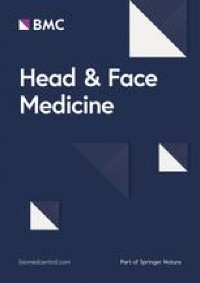|
Medicine by Alexandros G. Sfakianakis,Anapafseos 5 Agios Nikolaos 72100 Crete Greece,00306932607174,00302841026182,alsfakia@gmail.com
Αναζήτηση αυτού του ιστολογίου
Πληροφορίες
Ετικέτες
Τρίτη 29 Ιουνίου 2021
Exploratory analysis on the association of mental health disorders with in‐hospital postoperative complications and mortality in head and neck cancer surgery
Possible Involvement of Type 2 Cytokines in Alloknesis in Mouse Models of Menopause and Dry Skin
|
Neck Masses: Clinico-Radio-Pathological Evaluation
|
Comparing ultrasound assessment of thyroid nodules using BTA U classification and ACR TIRADS measured against histopathological diagnosis
|
Anthropometric analysis of linear parameters of the Indian nose: A cross-sectional study and comparison with literature
|
Identification of secondary predictive factors for acute hypocalcemia following thyroidectomy in patients with low postoperative parathyroid hormone levels without overt calcium deficiency: A cohort study
|
The use of solvent-preserved human and bovine cancellous bone blocks for lateral defect augmentation - an experimental controlled study in vivo
|
Anatomical Variations Associated With Maxillary Sinus Fungal Ball
|
Influence of the Electrode Array Design on Incidence of Vertigo Symptoms and Vestibular Function After Cochlear Implantation
|
Impact of intraepithelial capillary loops and atypical vessels in confocal laser endomicroscopy for the diagnosis of laryngeal and hypopharyngeal squamous cell carcinoma
|
Mild and moderate COVID-19 disease does not affect hearing function permanently: a cross-sectional study ınvolving young and middle-aged healthcare givers
|
-
Publication date: Available online 28 September 2017 Source: Actas Dermo-Sifiliográficas Author(s): F.J. Navarro-Triviño
-
Abstract Objectives To investigate factors related to reasoning skills in 434 school children aged 5–9 years. Methods The Leiter Interna...





